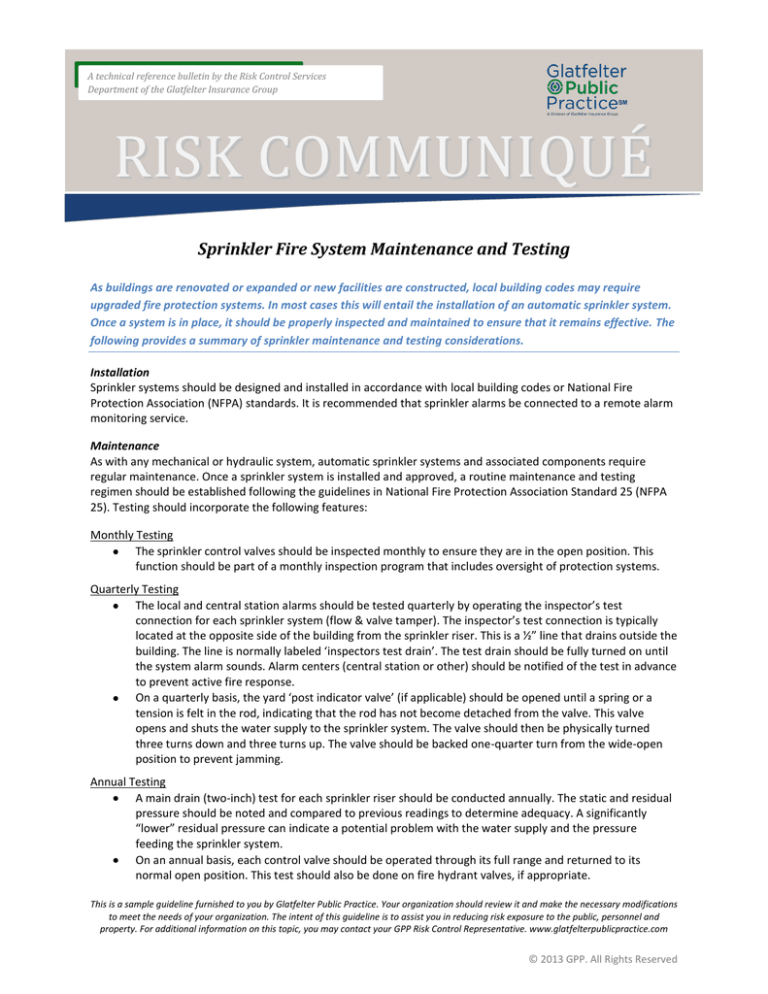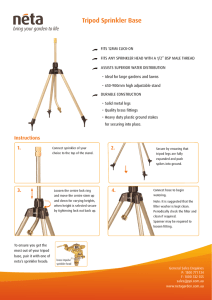
A technical reference bulletin by the Risk Control Services
Department of the Glatfelter Insurance Group
A
RISK COMMUNIQUÉ
Sprinkler Fire System Maintenance and Testing
As buildings are renovated or expanded or new facilities are constructed, local building codes may require
upgraded fire protection systems. In most cases this will entail the installation of an automatic sprinkler system.
Once a system is in place, it should be properly inspected and maintained to ensure that it remains effective. The
following provides a summary of sprinkler maintenance and testing considerations.
Installation
Sprinkler systems should be designed and installed in accordance with local building codes or National Fire
Protection Association (NFPA) standards. It is recommended that sprinkler alarms be connected to a remote alarm
monitoring service.
Maintenance
As with any mechanical or hydraulic system, automatic sprinkler systems and associated components require
regular maintenance. Once a sprinkler system is installed and approved, a routine maintenance and testing
regimen should be established following the guidelines in National Fire Protection Association Standard 25 (NFPA
25). Testing should incorporate the following features:
Monthly Testing
The sprinkler control valves should be inspected monthly to ensure they are in the open position. This
function should be part of a monthly inspection program that includes oversight of protection systems.
Quarterly Testing
The local and central station alarms should be tested quarterly by operating the inspector’s test
connection for each sprinkler system (flow & valve tamper). The inspector’s test connection is typically
located at the opposite side of the building from the sprinkler riser. This is a ½” line that drains outside the
building. The line is normally labeled ‘inspectors test drain’. The test drain should be fully turned on until
the system alarm sounds. Alarm centers (central station or other) should be notified of the test in advance
to prevent active fire response.
On a quarterly basis, the yard ‘post indicator valve’ (if applicable) should be opened until a spring or a
tension is felt in the rod, indicating that the rod has not become detached from the valve. This valve
opens and shuts the water supply to the sprinkler system. The valve should then be physically turned
three turns down and three turns up. The valve should be backed one-quarter turn from the wide-open
position to prevent jamming.
Annual Testing
A main drain (two-inch) test for each sprinkler riser should be conducted annually. The static and residual
pressure should be noted and compared to previous readings to determine adequacy. A significantly
“lower” residual pressure can indicate a potential problem with the water supply and the pressure
feeding the sprinkler system.
On an annual basis, each control valve should be operated through its full range and returned to its
normal open position. This test should also be done on fire hydrant valves, if appropriate.
This is a sample guideline furnished to you by Glatfelter Public Practice. Your organization should review it and make the necessary modifications
to meet the needs of your organization. The intent of this guideline is to assist you in reducing risk exposure to the public, personnel and
property. For additional information on this topic, you may contact your GPP Risk Control Representative. www.glatfelterpublicpractice.com
© 2013 GPP. All Rights Reserved
A technical reference bulletin by the Risk Control Services
Department of the Glatfelter Insurance Group
A
RISK COMMUNIQUÉ
Post Indicator Valve
All testing should be accompanied by detailed
documentation, including readings, dates,
contractor’s identification, etc., that should be
maintained in a historical file.
Some advanced sprinkler systems may need to augment water supply pressures through the use of a fire
pump. The fire pump is responsible for providing water and pressure to the building and yard fire systems.
The fire pump and components should be Factory Mutual (FM) or Underwriters Laboratories (UL) listed for
this purpose. As with the fire systems indicated above:
1. A regular maintenance schedule should be established for the fire pump.
2.
The fire pump should be inspected weekly by qualified in-house personnel and quarterly (as a minimum)
by qualified in-house personnel or a contractor should put the pump through a system run per
manufacturer’s specifications. Each pump manufacture will provide guidelines for routine maintenance
that should be followed.
3.
A key component to fire pump reliability is the annual performance capacity test. This is really the only
“sure-fire” way to determine whether the pump is operating as output rated and designed. Each fire
pump has a rating that indicates it will provide a certain gallons per minute (GPM) output at 100%
indicated pressure. This test is to verify the fire pump is still operating as designed. The annual capacity
test will ensure that the equipment is in full operable condition. As with the sprinkler systems, the
maintenance and testing routine for the fire pump should follow the guidelines found in National Fire
Protection Association Standard 25 (NFPA 25). This testing brings the fire pump to 100% rated capacity
and pressure to 150% rated capacity at 65% rated pressure.
4.
A detailed record of fire pump testing should be kept on file. If deficiencies are found, a licensed pump
contractor should be brought in to repair the fire pump.
NOTE: Very few public entities have the in-house staff trained to conduct the testing described above. Normally a
qualified fire protection service contractor is utilized to test, maintain, and repair automatic sprinkler systems and
components.
This is a sample guideline furnished to you by Glatfelter Public Practice. Your organization should review it and make the necessary modifications
to meet the needs of your organization. The intent of this guideline is to assist you in reducing risk exposure to the public, personnel and
property. For additional information on this topic, you may contact your GPP Risk Control Representative. www.glatfelterpublicpractice.com
© 2013 GPP. All Rights Reserved




